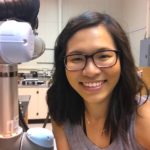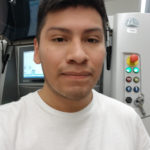Anthony Medellin
 Institute: Texas A&M University
Institute: Texas A&M University
TAMU Mentor: Dr. Chao Ma
Graduate Student Mentor: Wenchao Du
Research Project: Vat Photopolymerization 3D Printing
Description:
The reinforcement material of the nanocomposites will be carbon nanotubes. After printing, they
will undergo post-processing and various tests to determine the mechanical and electrical
properties.
Ashley Luong
 Institute: Lamar University
Institute: Lamar University
TAMU Mentor: Dr. Prabhakar Pagilla
Graduate Student Mentor: Orlando Edison Cobos Torres
Research Project: Web-Based Software Tool for
R2R Cybermanufacturing (CM) Systems
Description:
Before the industrial era, people learned craftsmanship skills to produce goods that are expensive and are made in small volume. Now with the advanced machines in the industrial era, cheap goods are made in mass production in less time. One way to achieve this mass production is with the application of Roll-to-Roll (R2R) system, which refers to the application of different processes such as coating, printing, heating, etc. to flexible materials called webs while being transported on rolls. For electronic devices including thin-film batteries, flexible panel displays, photovoltaics,engineered surfaces, and flexible solar films, etc., require ultra-high performances with remarkable precision need developed machines to do so. When a web is moving between two rollers, we have to take longitudinal and lateral behaviors into account. Information about lateral behavior is scarce. The goal of this work is to develop a world wide web (www)-based software that can predict the lateral motion of a moving web on rollers at any position and at any time, in order to provide a better understanding. The animations and simulations will allow us to visualize the lateral motion along the web path, which then can provide the guidelines for web guide mechanisms.
Vasant Kurvari
 Institute: Texas A&M University
Institute: Texas A&M University
TAMU Mentors: Dr. Arun Srinivasa, Dr. P.R. Kumar
Graduate Student Mentor: Jason Wang
Research Project: Advanced Manufacturing for Kirigami
Structures: A Comparative Study
Description:
The work topic is if it is possible to create kirigami foldable polymeric structures using a Laser Cutter or a Computer Numerical Control (CNC) Milling Machine, and if so, what are the effects and how do they compare. We will explore the physical properties of the polymers, the foldability and repeated folding, and the durability and sturdiness.
Edgar Palapa
 Institute: California State University, Los Angeles
Institute: California State University, Los Angeles
TAMU Mentors: Dr. Alaa Elwany
Graduate Student Mentor: Bing Zhang
Research Project: Process Planning and Optimization in the Additive Manufacturing of Nickel Titanium Shape Memory Alloys
Description:
Nickel-Titanium (NiTi) alloys have a special property known as Shape Memory Effect. This property allows the alloy to be deformed and maintain that deformed shape. The special part of this property is that when NiTi is heated up to a certain threshold temperature, the alloy will return to its original undeformed shape. This property has important applications in the fields biomedical, aerospace, and automotive engineering. Traditional manufacturing of Nickel-Titanium is challenging due to its mechanical and
chemical properties. These properties have limited NiTi manufacturing to very simple geometries. However, Additive Manufacturing (AM) has presented a promising solution to the manufacturing process of NiTi. This manufacturing method uses laser beams to melt NiTi powder layer-by-layer, essentially ‘building up’ the part. This process facilitates the manufacturing process of complicated geometries that were previously not feasible. Additive Manufacturing is not without its challenges; the production planning of NiTi is challenging as a result of additional process parameters (laser beam power, laser beam size, scan speed, etc.). To overcome the challenges of AM, process parameters must be optimized to produce quality NiTi parts.
Merryll Dewabrata

Institute: Texas A&M University
TAMU Mentors: Dr. Satish Bukkapatnam, Dr. P.R. Kumar
Graduate Student Mentor: Ashif Iquebal
Research Project: Change Detection in Nano-indentation Setup
Description: The research will be focused on change detection in a nano-indentation setup. Nano-indentation is a way to test physical properties of materials by scratching the surface with a highly precise needle. The setup includes several visual and acoustic sensors. The goal is to determine whether we can tell when the needle grazes different grains on the surface of the material from acoustic signals, and if this is possible, to develop an app deployable in the cloud for change detection. In this project, we will analyzing physical signals from the scratching process and collecting these signals on the computer, where we will connect them to physical properties. We will be analyzing acoustic and other signals to tell when the indentation needle grazes different grains on the surface.
Mussie Negash

Institute: Texas A&M University
TAMU Mentors: Dr. Natarajan Gautam
Graduate Student Mentor: Jin Xu
Research Project: Online Data Collection and closed-loop Control in Cyber Manufacturing
Description:
Reliable sensors and electronic devices are built in a CNC machine to collect data for product quality remotely, with data being processed and transmitted to the cloud through a Wi-Fi based data transmission module. Information is analyzed in cloud and feedbacks are sent to the machine so as to improve production efficiency and products quality.
Kristen Arias

Institute: Lone Star College/Texas A&M University
TAMU Mentors: Dr. Shiren Wang
Graduate Student Mentor: Biran Wang
Research Project: 3D Printing of Thermo-Insulated Thermosets
Description:
The goal is to determine the influence different patterns and layer density has on thermal insulation of thermosets. Thermosets are one of two types of plastics. The other kind is thermoplastics. The difference between the two is that while both may be initially melted down and molded into something, only thermoplastics may be melted down a second time and molded into something new. Thermosets, on the other hand, simply burns once it reaches a high enough temperature and cannot be melted again. Thermosets, in general, have a much higher thermal stability and insulation than thermoplastics.
In our research project, we are testing to see if thermal insulation of thermosets can be further improved. There are three steps. First, we have the 3D printer print the thermoset plastic object using different patterns. The 3D printer prints layer by layer, starting from the bottom. Our second step then includes changing the density of these layers. In our final experiment, each layer will have a different density. We will test the properties of the plastic after each step to see if there are any changes when it comes to thermal insulation.
Ximena Lopes

Institute: University of Texas at El Paso
TAMU Mentors: Dr. Bimal Nepal
Graduate Student Mentor: Kahkshan Afrin
Research Project: Manufacturing of Smart Wearables
Description:
Innovations in sensor and manufacturing technologies such as mobiles and electronic healthcare have made wearables a common device. Wearables can provide an affordable alternative to high cost hospitals and medical bills, as well as a comfortable setting for the patient. Wearables facilitate the monitoring of physiological signs of the patient in order to properly assess health and provide comprehensive feedback from distant facilities during the patient’s everyday life, without disruption while improving their way of life. Smart wearables allow the transfer of data between the product and a smartphone or device; Wi-Fi and Bluetooth usually connect these. There are several different types of smart wearables such as those that diagnose and those that give a prognosis; these include textile-based sensors, body temperature monitoring systems, and many more. Several parameters that wearables measure, includes regulating blood oxygen saturation level, skin temperature, heart rate and determining the pattern of a particular disease. Wearables are usually minimally obtrusive, accessible and somewhat affordable. Although there are many benefits to these smart wearable devices, complications do arise. Some problems for smart wearables and their manufacturing include battery life, comfort and durability, privacy in connectivity, data storage and personalization. In this project, we aim to do a thorough analysis of smart wearables, their challenges, their manufacturing and new up and coming technologies for smart wearables such as 3D printing.
Kyle King

Institute: Bradley University
TAMU Mentors: Dr. Satish Bukkapatnam
Graduate Student Mentor: Ashif Iquebal
Research Project: Optimal magnetorheological fluid for localized polishing of freeform surfaces
Description:
Magnetorheological fluids are a type of fluid that can change properties in the presence of a magnetic field because of the mixture of magnetic particles within the fluid. In this study, a mixture of abrasive materials will also be included within the fluid. In the automobile and aerospace industry there are many parts with difficult to reach areas where the use of magnetic fluid finishing could be used to create the desired surface smoothness. The biomedical field could use this technique specifically for implants such as knee implants. The joint area where rubbing occurs needs to be smooth, but the other areas of the implant need a rougher surface in order to adhere to materials around the knee. Electropermanent magnet arrays can be used for localized finishing of surfaces with the use of magnetorheological fluids. The magnets are used to excite the magnetorheological fluid being used creating a normal force on the surface being polished. The goal of this project is to optimize the fluid mixture so that the necessary properties are created. These properties include the optimal amount of fluid flow as well as the sufficient amount of stiffening of the fluid to create the down force needed to polish the material properly. These localized finishing techniques can be utilized in many different industries to polish products in the necessary areas for maximum effectiveness.
Russell Rowe

Institute: Lamar University
TAMU Mentors: Dr. Matthew
Graduate Student Mentor: Cole Flincher
Research Project: Optimization of Void Placement in Ecoflex for Maximum Fracture Strength
Description:
This project will study Ecoflex, which is the most common substrate material in flexible electronics. Dr. Pharr’s group has found that Ecoflex has several unusual properties. One property is that if a pre-cut is introduced and a tensile load is applied the material will tear, which is expected. However, if the tear collides with a void in the material or if the tensile stress is applied slowly (small strain rate), then the tear will “turn” 90° and not travel along its expected route. Usually this “sideways” crack is stable, and the material will continue to sustain load.
